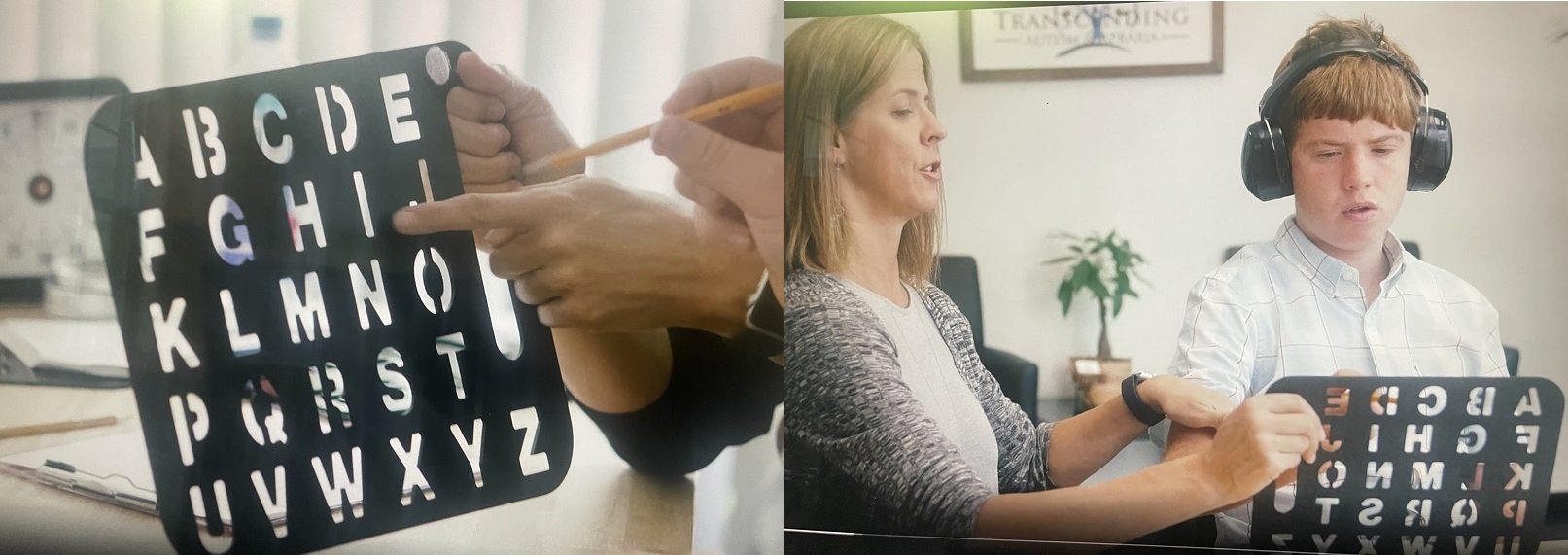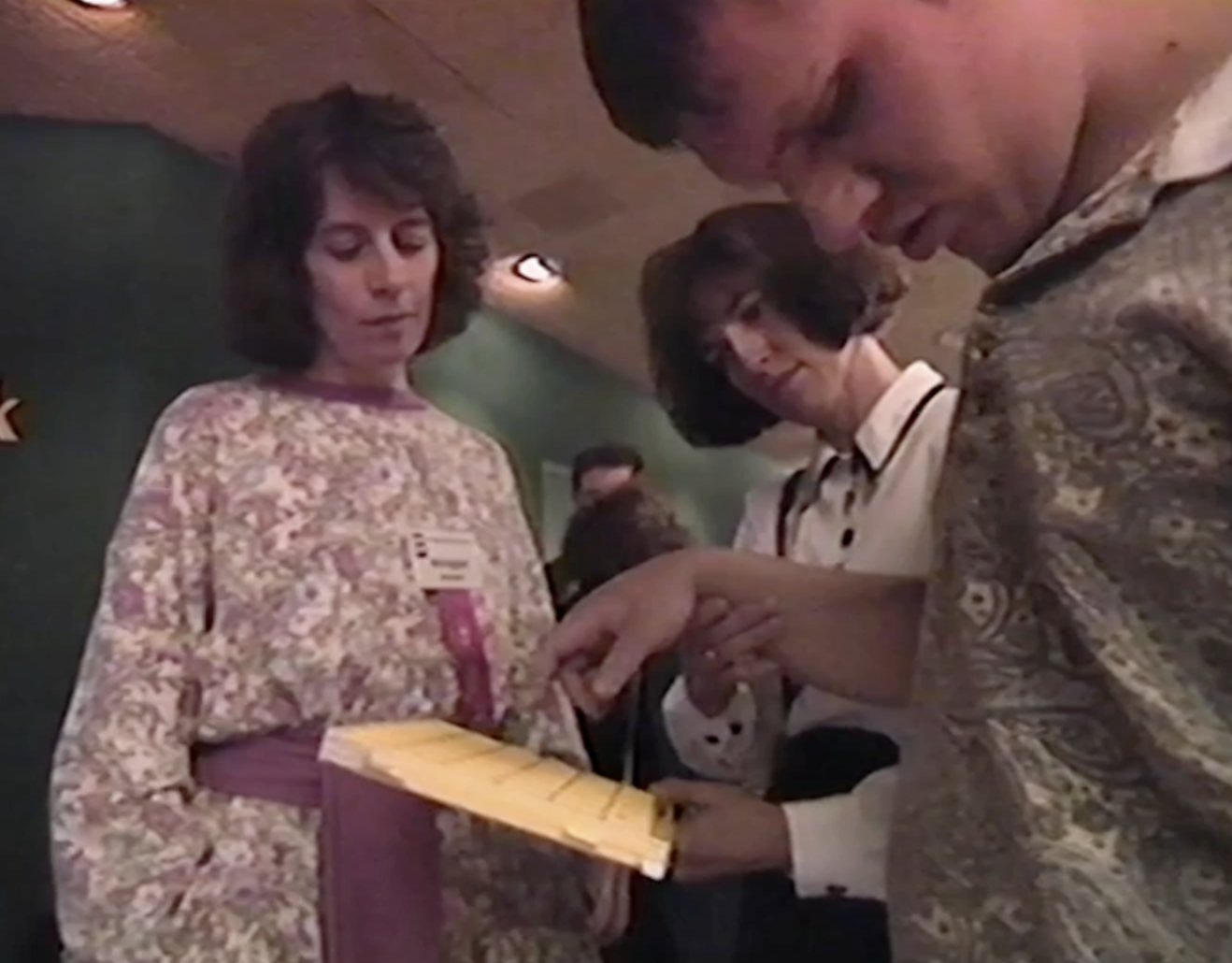What Forbes Contributor Steven Aquino Forgot to Mention About the Spellers Method
Today’s blog post is a continuation of a series I’m writing to answer a reader’s question: How has FC changed since 1990? I originally planned to do a simple comparison between the 1993 Frontline documentary Prisoners of Silence and the 2023 film Spellers (see Katharine’s review here), but I realized the issues were too complex and needed more than one blog post to explain. I’ll post links to my previous blog posts from the series below (along with other relevant posts), but if you haven’t read Katherine’s post from last week, I strongly suggest you do. It gives some context as to the dubious claims being made by S2C proponents and further explains the problems I have with a recent article written by Steven Aquino and published in Forbes on July 18, 2024.
Dawnmarie Gaivin using a form of FC called “Spellers Method” with her son. In the first picture, Gaivin points to the letter I, in the second, she touches her son’s forearm. These physical cues (often inadvertent) aid in letter selection (from Spellers, 2023)
The article, titled “Inside Spellers Method’s Work to Get People Listening to Non-Speakers Everywhere,” reads like an advertisement for the movie Spellers and for Dawnmarie Gaivin’s rebranding of FC to the “Spellers Method.” Aquino claims to cover accessibility and assistive technologies, but apparently couldn’t recognize FC when he saw it. I find this disappointing, considering Aquino was a special education teacher before turning to journalism. He seems to have missed several key points about “the method” that someone trained in special education, IMO, shouldn’t have overlooked.
To be fair, a simple Google search might not have brought up much information about the “Spellers Method,” and there is no reliably controlled evidence to support Gaivin’s claims that “the method” produces independent and “robust” communication, so a JStor database search wouldn’t have helped him much either. From what I can tell, Gaivin didn’t start heavily marketing this “variant” of FC until around 2023, when the film Spellers was released. She is featured prominently in the film and before that published a series of YouTube videos extolling the virtues of Spelling to Communicate (S2C). But, pro-FC movies and YouTube videos, though interesting, fall into the category of anecdotes and testimonials, not reliably controlled evidence.
Elizabeth holding a stencil and providing hand signals to her client in an S2C session (WHYY, 2022)
If Aquino researched S2C, the FC variant “invented” by Elizabeth Vosseller which he mentions in his article, he might have found that S2C also has no reliably controlled evidence supporting claims of independent communication. S2C is an iteration of Rapid Prompting Method (RPM) invented by Soma Mukhopadhyay (see more about RPM and Mukhopadhyay here and here) and, like the other “variants” of FC, has no evidence to support it. S2C proponents have, over the years, managed to get credulous reporters (unfortunately, Aquino is not the only one) to write feel-good miracle stories about S2C in the popular press (see here, here and here). In addition, there is an on-going S2C court case in Pennsylvania in which parents sued a school system for not adopting the pseudoscientific method. We’ve written about it here and here. So far, the court has ruled in favor of the school system, but I understand the case is, once again, under appeal.
Aquino might have mentioned that Gaivin’s “method” is modeled after S2C and RPM and that by swapping out touch-based FC for holding a letter board or stencil in the air, proponents have (consciously or not) substituted one form of cueing and control for another. Proponents don’t seem to understand (or perhaps don’t want to understand) that cueing can and does occur even when facilitators are not directly touching the individuals being subjected to FC. The fact that facilitators are generally unaware of the extent to which their own behaviors influence letter selection doesn’t absolve them of the responsibility of checking to make sure their behaviors, however inadvertent, are not controlling authorship. But proponents are encouraged to “prompt their hearts out,” as this pro-FC article explains, and told that prompt dependency is not an issue. Somehow, despite this “prompt, prompt, prompting,” the individuals being subjected to FC/S2C/RPM are supposed to learn how to spell independently while practicing techniques for weeks, months, years that only work when the facilitators are within visual, physical, and auditory range. To my knowledge, there are no set protocols for fading prompts in FC/S2C/RPM training manuals. Fading prompts (or eliminating facilitator cueing and support) is essential to independent communication and on-going, covert or overt prompting by facilitators is what distinguishes FC/S2C/RPM from legitimate, evidenced based Augmentative and Alternative Communication (AAC). (See Katharine’s blog post here).
Soma Mukhopadhyay holding a letter board in the air and signals with her right hand during an RPM session. The client is not looking at the board while he points a stick toward the board. (From A Mother’s Courage, 2009)
Of course, proponents try to get around these criticisms by claiming S2C, RPM, and “the method” are not FC and staunchly refusing to test the techniques under reliably controlled conditions. But this brings up another problem. If, on the outside chance S2C/RPM and “the method” are not FC, then proponents have a responsibility to provide reliably controlled testing to back up their claims of independent and, as Gaivin claims, “robust” communication. By their own definition (but not mine—RPM has been around over 20 years) these techniques are “new” and “emerging.” Regardless, facilitators should be lining up to be tested to rule out facilitator influence and control over letter selection.
Master trainer Annegret Schubert interacts with a client in an FC session. The facilitator stares intently at the letter board while the client has his eyes closed. (Prisoners of Silence, 1993)
Aquino might also have mentioned that many organizations have position statements opposing the use of FC/S2C/RPM. (See Opposition Statements) These organizations cite lack of scientific evidence, concerns regarding prompt dependency, facilitator cueing, and potential harms (such as false allegations of abuse). Part of the rebranding effort by FC proponents, I believe, is so they can claim their form of FC doesn’t apply to these statements. But groups and organizations attempting to educate their members and the public about the dangers of FC are catching on to this practice and painting a broader brush in defining the technique. A great example of this is the University of Pretoria’s Centre for Augmentative & Alternative Communication that, in March 2024, released a statement titled “Position statement on expressive methods of communication for persons with limited speech that require the input of a trained supporter.” It’s a mouth-full to be sure, but I’m glad to see they’re bypassing specific pseudonyms for FC and focusing on facilitator behavior. I urge you to read their statement in full but want to highlight this section:
From the outset, we want to clarify that spelling, as a form of communication, has long been an accepted AAC method. However, it should only be recommended and used if based on a feature matching process (McMahon et al., 2023), which determined that spelling is the best way for an individual to communicate. Also, as with all other AAC methods, the messages generated should be those of the person using AAC and not those of the facilitator. (Bold text, mine)
Gaivin (and other FC proponents) claim that their techniques increase the autonomy of the individuals being subjected to them. But how is that accomplished, exactly? I’d love to see reliably controlled studies that measure the autonomy of individuals being subjected to facilitator-dependent techniques, because I just don’t understand their logic.
To me proponent claims of “success” with FC are (emotional) projections from facilitators who want so badly to help their client or loved one that they’ve lost their ability to look at the situation objectively. Journalists covering stories like these—stories that seem too good to be true—should approach the subject with at least a modicum of critical thinking skills. They should be demanding reliably controlled evidence from proponents to back up their extraordinary claims. Otherwise, reporters, like Aquino, end up giving peddlers of pseudoscience free advertising space to promote their unproven, disproven, harmful ideas.
Note: I reached out to Aquino before writing this blog post but have not received a reply.
Recommended Reading:
Beals, K. P. (2024). Can message-passing anecdotes tell us anything about the validity of RPM and S2C? Evidence-Based Communication Assessment and Intervention, 1–14. https://doi.org/10.1080/17489539.2023.2290298
Schlosser, R.W., Hemsley, B., Shane, H. et al. (2019). Rapid prompting method and autism spectrum disorder: Systematic review exposes lack of evidence. Review Journal of Autism and Developmental Disorders, 6, 403–412.
Hemsley, B., Bryant, L., Schlosser, R.W., Shane, H.C., Lang, R., Paul, D, Banajee, M., Ireland, M. (2018). Systematic review of facilitated communication 2014-2018 finds no new evidence that messages delivered using facilitated communication are authored by the person with disability. Autism and Developmental Language Impairments, 3, 1-8. DOI: 10.1177/2396941518821570
Schlosser, Ralf W. and Prabhu, Anjali. (2024, February 5). Interrogating Neurotypical Bias in Facilitated Communication, Rapid Prompting Method, and Spelling 2 Communicate Through a Humanistic Lens. Current Developmental Disorders Reports.
Select Blog Posts on the topics covered in today’s post:
Actually there are published authorship results for S2C/RPM…and they aren’t good
An inside look at S2C: “We actually discourage them from using their speech while they are spelling”
FC/S2C/RPM and False Allegations of Abuse
Has FC changed since the early 1990s?
New takes on apraxia, miracles, presuming competence et al. from S2C proponents
Response to Reader Question: Has FC changed since the early 1990s?





